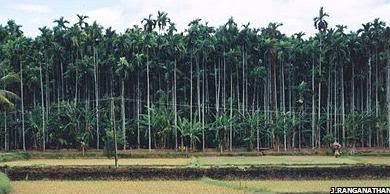Researchers: tropical plantation farms can aid biodiversity

The team of scientists from the US and India chose the site on the coastal fringes of the Western Ghat mountain range because it met a number of attributes the study required:
- a long history of continuous agricultural production
- intense human pressure
- extensive natural areas still remaining
The researchers found a total of 51 forest (bird) species in this study system, they wrote. These species were broadly distributed across the landscape, with 46 (90%) found outside of the intact forest. Within areca nut plantations, they recorded threatened forest species, such as the great hornbill (Buceros bicornis) and the Malabar grey hornbill (Ocyceros griseus).
The team said the combination of the height of the areca nut palms (Areca catechu) and the plantations' close proximity to the intact forest created the necessary ecological conditions to support forest bird species.
They added that data showed the distribution of species in the area had been relatively stable for more than 2,000 years, before the first farmers cultivated the area.
As well as having a high ecological value, the plantations were also economically productive. The areca nut is consumed by about 10% of the world's population, predominantly Asian communities.
The shade provided by the palms' canopy also created the conditions that allowed farmers to grow other high-value crops, such as pepper, vanilla and bananas.
Rather than expanding the plantations, the farmers relied upon the leaf litter from the surrounding production forests to produce mulch for their crops, rather than using costly fertilisers. The researchers also said alternative crops that could be grown in the wet lowlands, such as rice, yielded lower returns both economically and ecologically:
 energy :: sustainability :: biomass :: bioenergy :: biofuels :: tropical :: plantation :: biodiversity :: forest ::
energy :: sustainability :: biomass :: bioenergy :: biofuels :: tropical :: plantation :: biodiversity :: forest :: Lead author Jai Ranganathan, from the US National Center for Ecological Analysis and Synthesis (NCEAS), said the findings provided another option for conservationists to consider
If it is not possible to make places completely protected areas then they can look at whether a system like this will help support the rich biodiversity. [...] It identifies another tool that can be used by conservationists. - Dr Jai RanganathanWhile the production system delivers economic and environmental benefits, health officials have voiced concerns about how the areca nut, which contain a stimulant called arecoline, is primarily consumed.
It is chewed either by itself or as a part of "betel quid", which generally consists of a betel leaf (from the Piper betle vine) wrapped around pieces of areca nut, slaked lime (calcium hydroxide) and generally tobacco.
In 2003, the International Agency for Research on Cancer (IARC) issued a warning that linked chewing areca nuts to an increased risk of cancer.
Dr Ranganathan said the researchers were aware of the health concerns associated with the areca crop, but the purpose of the study was to understand how tropical agriculture and biodiversity could co-exist in close proximity.
Areca nut cultivation has an extremely long history in south and south-east Asia and is likely to continue for the foreseeable future, he said. Given this persistence, I feel that it would be a shame to overlook the potential benefits of this cultivation system for biodiversity.
Dr Ranganathan said that he intended to look for further examples of established agriculture and cultivation practises in the region that provided habitats that supported a high level of biodiversity.
The research indicates that low-impact tropical biofuel plantations can be made equally sustainable, even at the forest frontier, and possibly help millions of the world's poorest.
References:
Jai Ranganathan, R. J. Ranjit Daniels, M. D. Subash Chandran, Paul R. Ehrlich, and Gretchen C. Daily, "Sustaining biodiversity in ancient tropical countryside", PNAS published early edition, November 3, 2008, doi:10.1073/pnas.0808874105
 --------------
--------------
 Mongabay, a leading resource for news and perspectives on environmental and conservation issues related to the tropics, has launched Tropical Conservation Science - a new, open access academic e-journal. It will cover a wide variety of scientific and social studies on tropical ecosystems, their biodiversity and the threats posed to them.
Mongabay, a leading resource for news and perspectives on environmental and conservation issues related to the tropics, has launched Tropical Conservation Science - a new, open access academic e-journal. It will cover a wide variety of scientific and social studies on tropical ecosystems, their biodiversity and the threats posed to them.









1 Comments:
Biodiesel from cellulose via fungus, found in Patagonian forests.
Incredibly, Biopact isn't where I read it first! Probably you guys already knew and were just digging a little deeper before posting :-)
Post a Comment
Links to this post:
Create a Link
<< Home